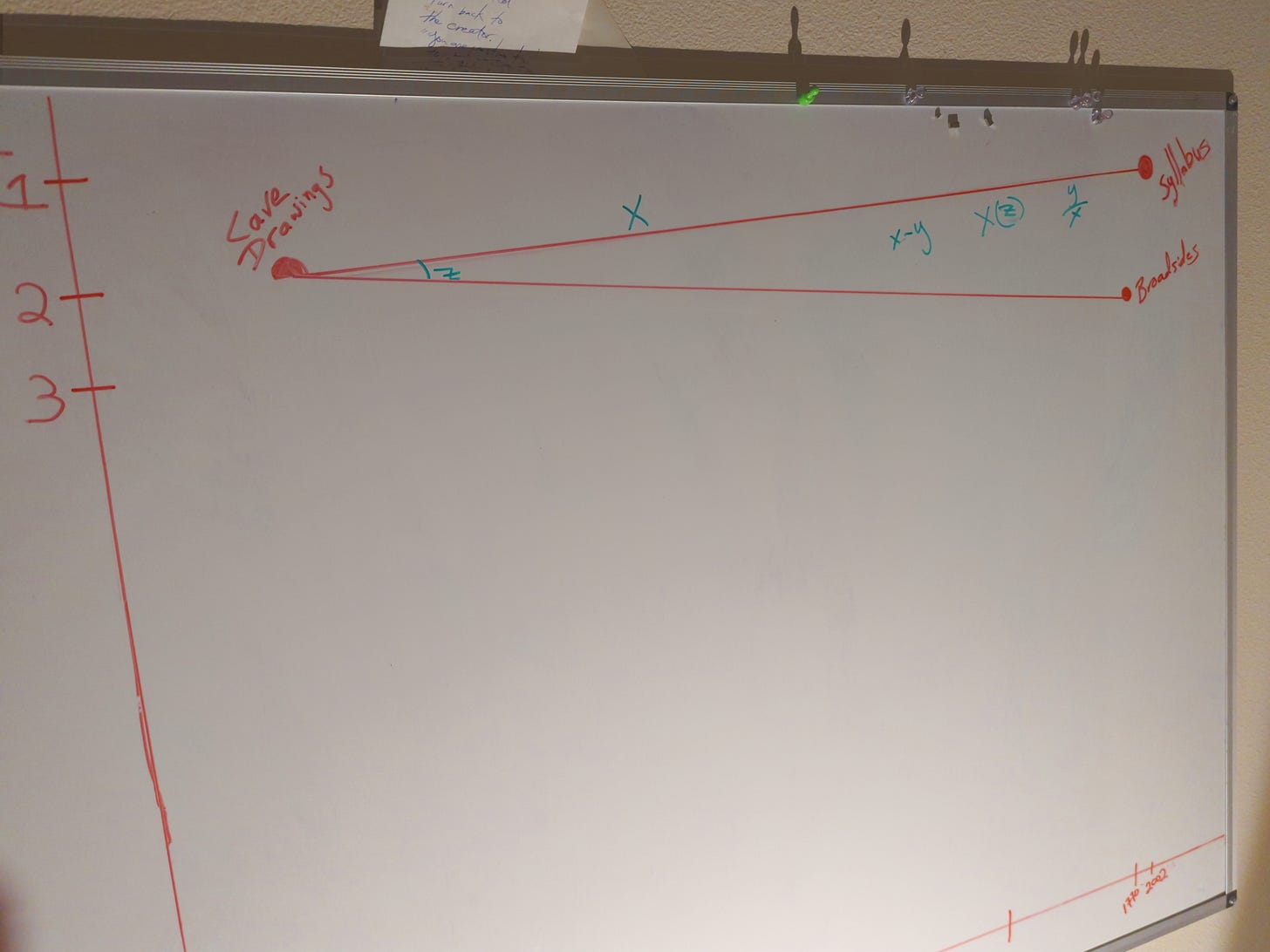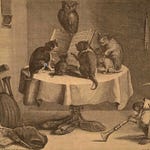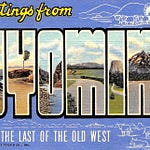Today we present an excerpt from Joel Byron Barker's upcoming book Clear and Sane: The Craft of the Green Paintbrush. The full text of the chapter is below if you prefer to read and create Cardio Plathemy’s accent yourself!
The novel is about four curious characters making their way through the emerging technology of the early 2000s America. It revolves around the birth and growth of a company called The Green Paintbrush as it becomes influential in crafting our experience in the modern world.
The Green Paintbrush is formed by Cardio Plathemy, a math-minded cypher. In 2002 he has decided to become a professor in order to recruit the minds needed to create the agency he imagines. In this chapter he steps into his first classroom to relate to that distinctive species, the American College Student.
You can learn more about the book at joelbyronbarker.com.
Joel is currently running a kickstarter campaign to spread the word about his book. You can contribute and in exchange get a hardcover book or even a custom idea scawled on a napkin by Cardio himself. The Kickstarter run until September 30.
Chapter 7: Teaching (2002)
This was not the first class Cardio stood before. The recommendation from Stanford that he brought to the dean was from a statistics course he was asked to teach a few years ago. It was inauspicious, as the students and the teacher quickly developed a mutual disinterest in each other. The Dean of the Stanford School of Business enjoyed Cardio’s presence at cocktail parties and felt that the reviews and outcomes of the class itself were of little import.
Having read a case study on Clear and Sane Roads, the Dean also felt that Cardio was something of a VIP in the world of business. A most obscure type of VIP, that referencing him showed deep knowledge of minutiae. Knowing Cardio personally was still more impressive. He was happy to write the letter.
So on a bright fall day in Spokane 2002, Cardio walked back into the Herack Center, heading for his own classroom and a pack of 22 young Americans varying in age from 19 to 26. He tried to focus on acting like a teacher.
When this all began, at his breakfast table, fueled by the new idea, he had gone ahead and written a plan for the course, complete with books and references. The books were directly from his own shelf or the important books of his youthful study.
He got a little sentimental when he discovered that a foundational statistics survey he had dog-eared in college was now out of print.
When he had that head of steam, he looked up at the mountain, the mountain now gleaming under a blazing noontime sun, and said aloud, “Maybe I will be a good teacher.”
He found it helpful now, to reflect on that moment. He had his notes and he had his printed syllabus to hand out. Two of the younger students had brought all of the books on his reading list to class and had even stacked them in a tapering tower on their desks.
“Hello. My name is Cardio Plathemy and I am your teacher for this class, Mathematics of Communication. If this is not the class you meant to be in…too bad for you. Drop that class tomorrow. Stay here with us today.”
Cardio’s voice is very even and his expression quite serious. He paused for a long time, waiting. He consciously pushed the charming smile across his face that had cued appropriate laughter in the past. It was moderately successful this time as well. He pushed the stack of papers forward on to the desk and pointed at the woman in the frontmost rightmost (from his perspective) desk.
“Please pass around this syllabus and I will introduce the course.” She was a little taken aback at being asked to rise, but did as she was told. He watched as she took the stack and split it in two at his table. She then took the two stacks back to her desk. One she handed to the woman behind her and one she handed to the young man to her right.
“Interesting,” said Cardio out loud, and took a small notepad out of his bag. He sketched a grid and drew arrows from one corner to both directions and wrote “outcome?”
He realized that he should have been talking to the class at this point. Leaving the notepad open on his lectern, he made eye contact briefly with several members of the class and started into his remarks.
“Over the all too brief semester, we will cover the mathematical basis for a variety of communication modes, observed in situ as best we can.
“This will probably involve algebra, algebraic geometry, and some trigonometry. As you noticed, there is no specific math prerequisite for this course. Rather, I have assigned books that can help us to derive the appropriate formulas, and then solve them as best they can be solved. There are no actual reading assignments, all of the books are optional.”
He was not aware, and had he been aware he would have viewed it as insignificant to all outcomes, that his books totaled $42 when purchased from the University bookstore.
“The syllabus before you is the best that I could offer you for structure in the course. I considered organizing this class as a chronological survey of communications methods, but then I was not so sure that such an organization would build a good cognitive experience in the student. You see, the assumption would be that we would move from simple to complex, as that is the traditional direction of a college course. However, the equation of an early novel might not build upon and increase complexity from a cave drawing. I was concerned that we would not have a cohesive experience and you would leave class on the last day slowly shaking your head, cursing my very name under your breath.
“So you can see that the syllabus is a listing in table form. The first column is the week of our semester. The second column is the year, date, or era of the subject that we will cover. The third is a short title, and the fourth—the widest column—is a short explanation.
“I am not very happy with the syllabus, because it does not illustrate a progression, nor the relationship between these items. It could just as easily be a grocery list of unlike items. “Apples, refried beans, 5W-30 motor oil. No, it is a bad syllabus. So, our first task today is to make a new syllabus that will provide you with some more information about what I am going to do with this class.
“If the class was perfectly chronological, I could have made a timeline. A timeline is of course a one-dimensional chart, simply an x axis. As such, the only directions to travel are up and down. The primary method of moving along it would be to add or subtract.”
Cardio felt some gratitude when he took up a dry erase marker and turned toward the board. For a time, his face relaxed from the series of practiced facial expressions. He drew a very clean and straight horizontal line near to the bottom of the dry erase board. Having freehanded tables and charts for a lifetime, Cardio’s steady hand could pinstripe a kilometer-long train without a waver. He placed perfectly vertical hash marks at even intervals across the line.
“However, since this class is not chronological, we need to express the ‘class time’ in another manner. I need to introduce another dimension, another axis.” He proceeds to draw a vertical line up from the center of the x axis. “This also represents time, but it represents our class time, the fifteen weeks we will spend together in this cozy little room.
“Today, our first incident is already happening; we are looking at our own syllabus as an item to analyze. So, the first item to plot is in the top right; week 1 day 1 intersected with the present day, 2002.” After putting a large dot on the upper right of the board, he turns toward the class, “And what is your name, sir?” The dry erase pen extending with astounding accuracy to indicate a young man in a broad-striped polo top. Green and white. He had short cropped blonde hair sprouting in a carefully haphazard manner. Cardio chose him because he was in the middle of the class and was looking directly at the board as Cardio turned.
“Phillip.” Phillip has a surprisingly husky voice.
“Phillip Phillip Phillip. You must all understand that I frequently fail to recall names of acquaintances. Soon, we will all be very close friends. However, please have patience with me as our relationship grows and strengthens. We can all laugh together at my little failings as a teacher. I am a little rough around the edges, but will strive to improve. So, Phillip, can you help me and let me know what the next item is on the syllabus? The next row in the poor table on the paper before you?”
“The probability of cave drawing and petroglyphs.”
“Oh dear. That is a long ways back.” He writes ‘38,000 BC’ on the far left of the x axis, then reaches up and draws a gently downward sloping line from the syllabus dot to a point high above 38,000 BC. OK. Now Philip, what is the next stop?”
“Broadside distribution in revolutionary America.”
“Thank you Philip.” A hash is assigned 1770, a dot is placed above it, and the line snakes back to the right. “Well, you can see how this is going. Interesting, eh? Now we have three points, we can compute the distance traveled along both axes, we can compute how steep the slope is, we can identify angles. We can do math.” He has taken up a green pen and is highlighting elements across the two axis timeline.
“Your first assignment: for the next class, I would like for everyone to recreate this and finalize it as a presentation-quality chart. Then, express that depiction in words.”
A mousy boy raises his hand and simultaneously asks, “how many pages?”
“What is your name, sir?”
“Roy.”
“Roy Roy Roy. Use as many words as you need but as few as possible.” Cardio puts down the dry erase marker, picks up his pen, and makes a three-word entry into the small notepad that was still sitting on the lectern. “Roy in box.”
“So, I have been somewhat sneaky here. I have taken the explanation of the syllabus and made it a lesson. But please, let me return to the business of learning and ask you now if there are any questions about the syllabus? Any concerns?”
“What will you test us on?” Roy again. Cardio marks a hash next to “Roy in box.” He underlines the phrase as well.
“That is yet to be determined. Any other questions?” Cardio focused his eyes on Roy, hoping that it would cause the boy to shrink and not follow up.
“Well how can we prepare if we don’t know what the test is?” A second hash mark. With your naked eye you could see that this one stretched slightly longer than the previous one. With a microscope, you could see that the pen dug significantly deeper into the paper.
Cardio’s voice turned cold, “I would suggest that you attend class and listen to your teacher. Does anyone else have any questions or comments on the syllabus?” He was pretty certain that the vicious tone would prevent further questions, and he was correct. After a brief silence that held only Roy’s loud, embarrassed breathing, Cardio wrapped up.
“Well, since there are no other questions, I look forward to working with all of you on Thursday but I am happy to give over the rest of this class time to your other indulgences. Class dismissed.” Cardio flipped the notebook closed and put it into his bag. The topmost frontmost woman had stood up, picked up a heavily stuffed backpack and put it on her chair. She was unzipping it when Cardio stepped around the table and put his hand on the surface of her desk to get her attention.
“And what is your name?”
“Cherry.” Cherry wore her blonde hair long, past her shoulder, with longish bangs. If you got the impression that she had the same hairstyle since middle school, you would be correct. She wore cargo pants and a fashionable top, highlighted with some sort of metallic glitter.
“Cherry, forgive me, I am not normally a teacher. Can you tell me if it would be unusual for me to ask to glance at your notes?”
She looked at him sidelong, “No teacher has asked me that before, but you may.” She had closed the cheap green vinyl portfolio around her legal pad and had it in her hand already. She handed it, still closed, to Cardio. Cherry kept her eyes on his face while he flipped it open.
“I noticed that you took four pages of notes during the class and I was curious, as a method of ascertaining the experience of attending the lecture, if I could find out what content you felt fit to record.”
Cherry’s handwriting was a scrawl, a code for only her. The more interesting code was how she used the page. Instead of writing across the page from margin to margin, her page was populated with rectangles and circles. They varied in height but took up either the entire width, 2/3 of the page, or 1/3 of the page. Generally sticking to the cardinal directions, lines traveled the page.
“What is the darkening of the contact point here and here signify?” Cardio asked.
It is amazing how quickly a classroom can empty out. The last of the class was clogged at the door, squeezed from disorder to a single file path through the door, and then chaotically in varying directions, in their own manner and pace. Only Cardio and Cherry were left in the room.
Cherry had one hand in her backpack, holding the place that the portfolio belongs. “Those are relationships that could become discussion or essay. There seems to be something to examine.”
“And the corkscrew right before some connection points?”
“Connections that I made, not a part of the lecture.”
“Very interesting, Cherry. You always take notes like this?” Cardio handed back the open portfolio. Cherry had to take her hand out of her backpack so that she could take the floppy thing from his hand and close it.
“Yes, mostly.”
“Have a lovely day, Cherry cherry cherry.” Cardio returned to his lectern to gather his own bag. Cherry noted that he took the small notebook back out of the bag, flipped it open expertly, and wrote a brief couple of lines.
Be among the first to get the whole book
Join the Kickstarter; help promote the book and get early access. Perhaps even an original thought by Cardio scawled on a napkin.














